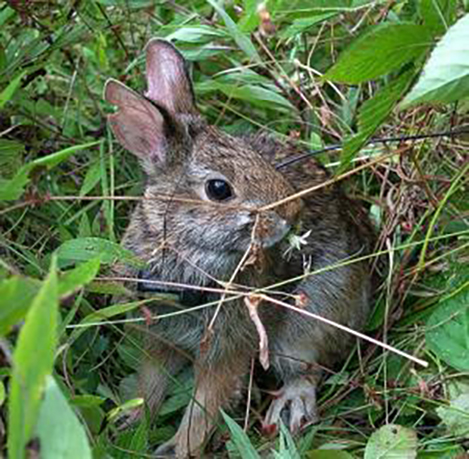By TODD McLEISH/ecoRI News
contributor
 |
New
England cottontails need thick habitat year-round.
(M. Poole/USFWS)
|
More rare New England cottontails
were raised at Roger Williams Park Zoo in Providence and the Queens Zoo in New
York City and released into the wild than ever before, according to
conservation officials.
The success is a positive sign for populations of the
region’s only native rabbit, which had declined precipitously in recent decades
because of habitat loss, hunting, and competition with the introduced eastern
cottontail.
Seventy-seven New England
cottontails were raised and weaned at the two zoos in 2018, almost double the
number weaned in each of the past few years.
Including animals taken from a
breeding colony on Patience Island in Narragansett Bay, about 100 cottontails
were released into the wild in Rhode Island, New Hampshire, and Maine last
year.
The reason for the tremendous
breeding success in 2018 is still a mystery, however.
“I wish I knew why it was so
successful,” Perrotti said. “We didn’t do anything different.”
“We’re somewhat baffled ourselves,”
added Heidi Holman, a wildlife biologist for the New Hampshire Fish and Game
Department and chair of the New England Cottontail Population
Management Working Group.
“We’ll continue to review our data in more
detail to see if we can tease out a variable, but there doesn’t seem to be any
particular thing we can put our thumbs on just yet to explain it.”
The breeding program began in 2010
with six cottontails collected from a wild population in Connecticut. Since
then, 163 litters have resulted in 301 weaned cottontails, mostly raised at Roger Williams Park Zoo.
The Queens Zoo joined the effort in 2015.
Once the rabbits are about 35 days
old, they are removed from the zoos and brought to what the biologists call
“hardening pens” at Ninigret National Wildlife Refuge in Charlestown, R.I., or
the Great Bay National Wildlife Refuge in New Hampshire to become acclimated to
natural conditions.
After they spend several weeks or months adjusting to the
environment, gaining weight, and learning to hide and forage, they are released
into the wild.
Decisions about which animals are
released in which location are based largely on their genetics.
“We’re trying to diversity the gene
pool and track who’s successfully mating so we’re not over-representing
particular genes in any one population,” Holman said.
Representatives from each state in
the region submit what Perrotti called “a wish list” of how many cottontails
they would like to release in their state annually, and based on the number of
animals available and their genetic makeup, the rabbits are divvied up and
delivered.
New Hampshire and Maine have
experienced the largest decline in their New England cottontail populations, so
they receive animals each year for release.
Cottontail populations in
Massachusetts and Connecticut are more robust, and wildlife officials there believe
they may be able to increase the populations by manipulating habitat rather
than augmenting the population with captive-bred rabbits.
In Rhode Island, New England
cottontails were initially released on Patience Island, which at last count had
between 56 and 90 animals, according to T.J. McGreevey, a researcher at the
University of Rhode Island who serves as the wildlife geneticist on the
cottontail project.
A total of 51 rabbits from Patience have been released
elsewhere in the past three years, including in the Great Swamp Wildlife
Management Area in West Kingston.
“The Patience Island population is
being managed to prevent it from reaching carrying capacity,” Holman said. “It
could crash from disease or starvation if it grew too high, so we’re managing
it to keep the population healthy. That’s why we remove some animals from
there.”
Another sign of the success of the
breeding program is documentation that some of the released animals are
reproducing in the wild. New England cottontails released at the Bellamy River
Wildlife Management Area in New Hampshire have been reproducing since 2013.
Reproduction was documented among the cottontails released at the Great Swamp
in 2017.
As successful as the program has
been during the past eight years, it’s still well below its target of releasing
500 cottontails annually. To increase breeding capacity, the researchers plan
to establish a new breeding colony this year on Nomans Land, a 612-acre
uninhabited island off the coast of Martha’s Vineyard. Other islands are being
considered for similar colonies in the future.
In addition, the Bristol County
Agricultural High School in Dighton, Mass., has offered to provide assistance
in rearing cottontails for the project. The school has successfully raised
several varieties of rare turtles for release in the wild since 2012. Other
partner organizations will likely be added in the future.
“We’ve set the bar at 500 per year,
and we’ll see if we can get there,” Holman said. “But we’re just getting
started. The conservation strategy we’re following will continue through 2030.
We’re still out there actively trying to create more habitat, and some of that
habitat is just getting ready to have rabbits. We should have more places to
release them very soon. And we’re continuing to collect information on how they
survive and make sure we adapt our protocols to improve that success as much as
we can.”
Rhode Island resident and author
Todd McLeish runs a wildlife blog.